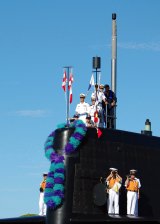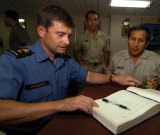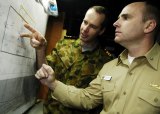|
|
Seven Pacific Rim nations along with the United
Kingdom participated in Rim of the Pacific (RIMPAC) 2006, a major maritime
exercise conducted in waters off Hawaii from late June through July 2006.
The exercise brought together military forces from Australia, Canada,
Chile, Japan, Peru, the Republic of Korea (ROK), the United Kingdom and
the United States. Conducted biannually since 1971, RIMPAC is a tremendous
opportunity for participating nations to enhance their forces’ skills in
fighting terrorism, countering weapons of mass destruction, combating
piracy, and providing humanitarian assistance.
Over 40 ships, six submarines,160 aircraft and almost
19,000 sailors, airmen, Marines, soldiers and Coastguardsmen participated
in RIMPAC. The exercise enhanced the tactical proficiency of participating
units in combined operations at sea that helps promote stability in the
Pacific Rim region. The U.S. Third Fleet, commanded by Vice Adm. Barry
Costello, was responsible for overall exercise coordination. Individual
units remained under operational command of their respective national
commanders throughout the exercise. Ecuador, India, Malaysia, Mexico, the
Philippines, Russia, Singapore and Thailand sent observers.
The month-long exercise involved several phases,
including a variety of drills and a tactical scenario play. During the
initial phase, personnel aboard ships and aircraft worked on improving
individual and task-group level war-fighting skills. Over a period of 10
days, the RIMPAC forces operated in waters off the Hawaiian islands of
Oahu and Kauai. Exercise events included live missile firings, torpedo
firings, gunnery exercises, air defense, surface and undersea warfare,
maritime boardings, mine warfare, non-combatant evacuation operations, and
amphibious operations.
Royal Australian Navy Commodore Rick Shalders was the
sea combat commander. The Commander of the Canadian Pacific Fleet,
Commodore Bruce Donaldson, served as the deputy commander of the combined
task force. Commenting on the first week of the exercise, Commodore
Donaldson said those days provided “an opportunity to meet, exchange, and
socialize with other exercise participants.”
Canada Assumes Leadership Roles
“Canada has assumed leadership roles in all facets of this very
large exercise, from myself as deputy commander through many levels, right
down to those who maintain aircraft,” said Commodore Donaldson. “Our
ability to integrate seamlessly in the overall RIMPAC structure is
critical as we grasp this extraordinary opportunity, and national
responsibility, to provide a Canadian perspective in resolving issues
concerning peace and security in the Pacific region.”
Canadian Air Force Col. John McManus, one of the directors
for the Combined Air Operations Center (CAOC) at Hickam Air Force Base,
said, “To the best of my knowledge, this is the first time a Canadian
officer has had the opportunity to act as a CAOC director in this type of
joint and combined exercise. We must train as we fight. Assuming
operational leadership roles like this one provide Canada the ability to
control its own resources. If we intend to send our people into harm’s
way, we must look out for them by being involved in the decision-making
process to ensure that our national interests are met.”
Canadian Navy Capt. Paul Hendry, commanding officer of the
area air defence destroyer HMCS Algonquin (DDH 283), led Surface
Action Group “Bravo” comprised of the Chilean frigate CS Blanco
(FF 15)¸ Peruvian frigate BAP Mariategui (FM 54), and the U.S.
Navy’s guided missile destroyer USS Shoup (DDG 86). Built in the
early 1970s, Algonquin is fitted with the most advanced
communications technology, giving the ship advanced command and control
capabilities.
Capt. Hendry noted, “While all sailors share a common
understanding of the challenges of the sea, RIMPAC is an opportunity for
allied nations to work together and further develop an understanding and
appreciation of each other’s individual procedures, capabilities and
limitations. This knowledge will be vital should we have to fight
alongside each other,” he added.
Also embedded within the Canadian Command staffs were
advisors from the Judge Advocate General, Policy and Public Affairs
offices of the Canadian Department of National Defence and the Canadian
Forces. “Legal and policy advisors add an important element of realism to
the operation of the headquarters,” said Commodore Donaldson. “The advice
provided helps ensure that coalition operations are conducted in
accordance with international and Canadian law, and provides an excellent
context for our activity.”
Live Missile
Firings
Canadian ships Algonquin and frigate HMCS
Vancouver (FF 331) conducted live missile firings on a military
range off the coast of the Hawaiian island of Kauai. Both ships exercised
anti-ship warfare engagements by firing against a surface target.
Algonquin fired a long-range SM-2 anti-air missile in an
anti-surface mode, while Vancouver fired two long-range
Harpoon anti-ship missiles.
The training continued the next day with an anti-air defense
exercise against remote controlled target drones. Algonquin fired
two long-range SM-2 anti-air missiles and Vancouver fired three
medium-range Sea Sparrow anti-air missiles.
Later in the week, Canadian patrol frigate HMCS
Regina (FFH 334) joined Algonquin and Vancouver
in a torpedo exercise. Six Canadian F-18 fighter aircraft exercised
air-to-air and air-to-ground warfare by dropping 40 MK-82 inert bombs on a
surface target. They also released eight air-to-air missiles against
airborne target drones.
Live missile firings, gunnery, and torpedo firings are some
of the highlights of the biannual RIMPAC exercise. Conducted on a military
range, these exercises help measure and analyze combat team and combat
system performance. All firings used realistic tactical scenarios.
“While computer simulation and modeling is an important and cost-effective
tool for team training and tactics development, personnel and system
performance can only be evaluated under live firing conditions controlled
by range safety regulations,” said Commodore Donaldson. “Live missile
firings also give the ship’s technicians and combat teams confidence in
their equipment, a critical factor and a morale booster for those who may
be called upon to sail into harm’s way.”
Air Operations
Command and
Control
Australian, Canadian, ROK and U.S. military members at
Hickam Air Force Base’s Pacific Air Operations Center (PAOC) in the
General George C. Kenney Headquarters (KHQ) provided command and control
for more than 200 sorties per day. At first, this presented some
challenges. “We speak different languages, and we found out initially that
we have different acronyms for things, but that all those things are
easily overcome,” said Brig. Gen. Greg Ihde, KHQ vice commander and PAOC
commander. “That’s why we practice; that’s why we have exercises.
That’s why it’s important to work together – not only with our Navy
brothers and sisters here, but also with our coalition partners.”
The key to success in a multinational environment
like this is communication. “A couple of people I’ve tried to talk to have
had difficulty understanding me because of my Australian accent, which I
find of course very hard to understand,” laughed Australian Group Capt.
Tony Needham, one of the combined air operations directors. “But
communicating is the key. We learn how to communicate with [U.S.
forces] better in a systems way, and we learn how to communicate better
people-to-people,” he said. “When we go home we’ll know people here. And
if we have to solve problems in the future, we’ll know who to call at
Hickam to solve problems.”
The exercise proved helpful for airmen. Canadian Capt Yuri
Mokievsky-Zubok, an F-18 pilot with about six months of experience, said
“Going through the training that I do go through, you learn that [the
PAOC] does exist and that this is where all the orders come from. I’m
learning quite a bit and seeing how the process actually comes together.”
Allied Navies Control
Supply Sea Lanes
Coalition building is a prime RIMPAC
objective, and that was evident within the logistical support arm of the
exercise. A coalition of Australian, Canadian and U.S. sailors controlled
the flow of materials and critical parts throughout the exercise. Their
efforts allowed dozens of operations held almost daily to run smoothly. It
was a daunting task, not only because of the size of RIMPAC, but also
because it involved coordinating with eight independent navies – each with
different systems, assets and languages. “The success of this RIMPAC is
that it is truly a coalition in nature to keep those parts moving,” said
Canadian Navy Lt. Chris Angerman.
One Australian and one Canadian Navy officer were the
material control officers onboard the aircraft carrier USS Abraham
Lincoln (CVN 72), which was one of two logistics hubs for RIMPAC
2006. The amphibious assault ship USS Bonhomme Richard (LHD 6)
was the other. The material control officers managed the distribution
network that included critical parts and materials flown to the carriers
as needed to keep participating ships and aircraft operating.
U.S. Navy Lt. Cmdr. Hans Lynch explained the critical role
of these officers. “We really couldn’t do this without them. With these
[allied-navy] officers, we’re getting trained professionals who do this
everyday. They know the material.”
The Australian, Canadian, and U.S. Navies share many of the
same classes of ships, as well as similar helicopters, weapons and
communications systems, which gives the material control officers an edge.
But when needed, they also provide support for the other allied nations
participating in RIMPAC.
“The majority of the freight we move from here is Canadian
and Australian, but we have moved one part for a Chilean Navy ship and
some mail for a Japanese ship,” said Lt. Angerman. He and 15 other
officers and enlisted sailors representing the three navies make up the
Forward Logistics Site (FLS) in Pearl Harbor. The FLS operates three H-3
Sea King helicopters at Hickam Air Force Base. The H-3s act as the
material control officer’s logistical arm from shore to sea. “We have
these three H-3s solely for our use. Usually we have to take tactical
helicopters from the ships, which can take away from the exercise. We’re
having success from a logistical standpoint,” Lt. Angerman said.
The logistical component of RIMPAC 2006 proved successful
not only on an operational front, but also from a coalition partnership
standpoint. “We have integrated very well and are very much a team,”
observed Lt. Angerman.
Keeping Communications
Running
Information Technology specialists from participating
nations worked in the coalition’s nerve center to keep communications
running between participating forces. The center is responsible for
monitoring computer systems, and relaying communications between
participants. The 15 service members working at the center allow RIMPAC
forces to coordinate all the events involved in the exercise.
“A lot of work and planning go into an event like this to
make it go smoothly,” said U.S. Navy PO1 Corey Mills. “We are learning
every day to prepare for any scenario that might present itself.” He noted
that radio telephonic circuits were used in previous RIMPAC exercises.
“Now we use an automated system,” he said. “It’s a more versatile
system which gives more nations a chance to play and be involved in the
exercise.”
U.S. Navy Lt. Jose Galito said, “This system allows us to
coordinate with air, sea and land assets. It lets the players
coordinate, collaborate, and participate with each other.” According to
Lt. Galito, computer models help to a degree, but having real-life
scenarios like RIMPAC gives participants the opportunity to learn and
improve their communication techniques, speed and accuracy for future
exercises. It also gives them valuable training that helps prepare them
for actual events.
To overcome language differences RIMPAC participants
included volunteers augmenting foreign units as translators. Their
participation facilitated the sharing of information between participating
nations, as well as observing nations preparing for possible participation
in future RIMPAC exercises.
Amphibious Assault and
Non-Combatant Evacuation Events
The last phase of RIMPAC 2006
was a scenario in which the participants worked together to enforce United
Nations Security Council resolutions to prevent one fictitious country
from invading another. As part of this role play, U.S. Marines conducted
an amphibious beach assault, non-combatant evacuation operations, and
raids on notional terrorist camps. Coalition air forces provided close air
support, surveillance, air strikes, and anti-ship and anti-submarine
warfare capabilities.
U.S. Marines from the USS Bonhomme Richard
skillfully navigated their Landing Craft Air Cushion (LCAC) hovercraft
across Bellows Beach on Oahu and through trees. The area represented the
hostile fictional country of Orange. Infiltrating Orange by helicopter and
LCAC, the Marines traversed enemy terrain and took control of the mock
U.S. embassy, which was nearly overrun by role players acting as rioters.
The Marines then evacuated more than 130 American citizens and four
foreign nationals.
Once the area was secured, evacuees began arriving in
trucks, helicopters, and even some by foot. The evacuees, who were sailors
acting as role players, were processed through the Evacuation Command
Center (ECC), where Marines performed security checks including
identification checks, bag searches, and pat downs. After being evacuated
by helicopter and LCAC, the evacuees were brought to Bonhomme
Richard, where they were berthed, fed, and provided medical
treatment. Navy medical personnel assigned to the ship and embarked with
the Marines also responded to a mass casualty drill during the NEO
exercise.
The NEO was followed by a CH-53D helicopter air raid on a
simulated terrorist camp at Dillingham Air Force Base in northern Oahu. In
addition, U.S. Marines from the amphibious ship USS Rushmore (LSD
47) launched an amphibious assault vehicle raid on a notional terrorist
camp in Kaneohe Bay.
U.S. Navy Capt. Steve Greene, commanding officer of the USS
Bonhomme Richard, said the teamwork between the sailors and
Marines was evident in the execution of naval and amphibious operations.
“These evolutions take a total Navy/Marine Corps team effort,” he said.
“The … team came together quickly and got the job done. Our watch standers
and bilateral partners protected us to ensure we were able to execute our
mission. Whether we’re taking the fight to our enemies or delivering aid
to our friends, our job is to get our Marines where they are needed, on
time,” he added.
Conclusion
RIMPAC
2006 provided an opportunity for allied nations to learn more about
working together. The exercise fostered teamwork between eight allied
nations, each bringing its own unique set of skills to the exercise. When
combined, these skills represent a coalition capability far stronger than
any one nation. RIMPAC 2006 helped fine-tune that coalition capability.
Commenting on Chile’s participation in the exercise, Vice
Admiral Gerardo Covacevich Castex, chief of naval operations said,
“Chilean prosperity relies on trade. The main road for this trade is the
Pacific, so we couldn’t be more happy to be participating in this combined
exercise.”
“We came to enhance our reputation,” said Commodore Richard
Shalders, commander of the Australian Navy submarine group. “We’ve been in
RIMPAC for more than 30 years as one of the principal players, and every
single time, we value what we get by coming this far, particularly from
the other side of the Pacific, with half our coastline facing this ocean.
RIMPAC provides an opportunity to grow and develop professional forces
capable of providing stability in our part of the world.”
“We had the opportunity to practice operational-level
command and control, as well as flying various tactical air missions
during the exercise,” said Canadian Col. John McManus. “Participation in
RIMPAC is critical because there is simply no substitute for the
experience gained by planning, training, and working in a coalition.”
“The exercise was a tremendous opportunity to learn and
improve how we work together,” said Vice Adm. Barry Costello, commander,
U.S. Third Fleet. “But more importantly, RIMPAC continues to build
positive relationships among allied nations who share a common interest in
peace, security and stability in the region.”
|
 |
Seven Pacific Rim nations along with
the United Kingdom participated in Rim of the Pacific (RIMPAC) 2006,
a major maritime exercise conducted in waters off Hawaii. Here,
ships from the participating nations sail in formation.
Photo by SN James R. Evans, USN |
| |
 |
Japan Maritime
Self-Defense Force submarine SS596 Kuroshio enters Naval
Station Pearl Harbor before the start of Exercise Rim of the Pacific
2006.
Photo by PO1 Cynthia Clark,
USN |
| |
 |
Onboard Peruvian Navy
frigate Mariategui (FM 54), Canadian Navy Commodore Bruce
Donaldson, deputy commander of the combined RIMPAC task force, signs
a guest book as Peruvian Navy MC Pedro Becerra Palma looks
on.
Photo by PO3 Marcos T. Hernandez,
USN
|
| |
 |
Royal Australian Navy
Cmdr. Philip Stanford (left) and U.S. Navy Cmdr. James Dicampli
coordinate submarine operations aboard the aircraft carrier USS
Abraham Lincoln (CVN 72).
Photo
by PO3 M. Jeremie Yoder, USN |
| |
 |
Australian Leading
Seaman Ben Abbott boards the USS Valley Forge, an
inactivated guided missile cruiser, during a simulated Visit, Board,
Search and Seizure (VBSS) event.
Photo by
PO2 Jennifer A. Villalovos. USN |
|